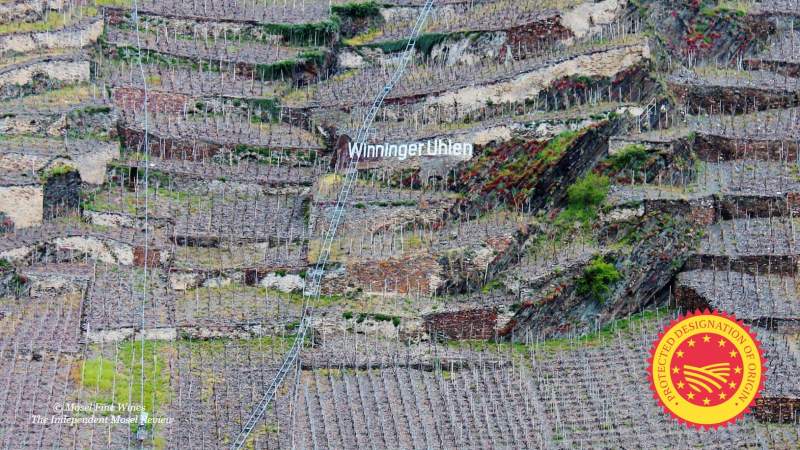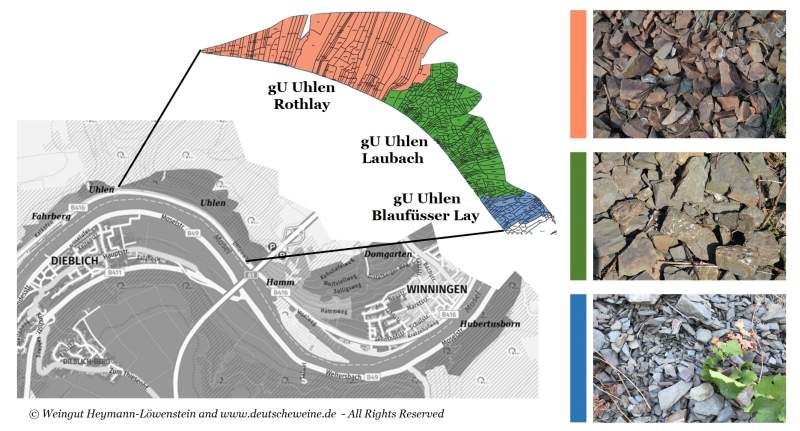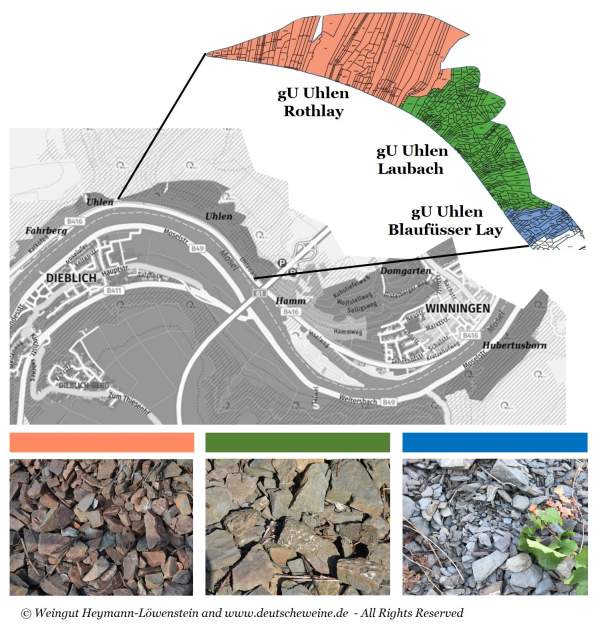November 12, 2018 | News | Vineyards

The Uhlen Blaufüsser Lay, Laubach and Roth Lay have been recognized as DPO / gU. The start of a new era for German wine?

The Protected Denomination of Origin (PDO or gU – geschützte Ursprungsbezeichnung – in German) is a way for EU Member States to ensure that certain unique products and processes rooted in terroir get equal recognition and protection within all EU Member States (and with other trading nations or trading blocks, when such provisions are foreseen in the trading deals).
These PDOs were first introduced in France (AOC, for Appellation d'Origine Contrôlée) and Italy (DOC, for Denominazione di Origine Controllata) and generalized as a principle throughout the EU over the last years. They apply to all sorts of products, but are central to the terroir-driven product called wine.
In October 2018, the last hurdle was taken for the approval of three more PDOs by the EU: The “Uhlen Blaufüsser Lay,” “Uhlen Roth Lay” and “Uhlen Laubach.” A small step for the EU, a big step for Germany as these are the first German single-vineyards to have received this status together with the Bürgstädter Berg (in Franken) and the Monzinger Niederberg (in the Nahe).
“Uhlen Blaufüsser Lay,” “Uhlen Roth Lay” and “Uhlen Laubach” refer to three different parts of the Winninger Uhlen vineyard in the Terrassenmosel (see picture here below). While contiguous to each other, the special geology of the Winningen area makes that these three sectors have completely different soil and thus a different aromatic profile: the Blaufüsser Lay is on a blue slate type of soil, the Roth Lay is on an red-colored and iron-rich slate and the Laubach is on a grey-slate soil).


The driving force behind this was Reinhard Löwenstein from Weingut Heymann-Löwenstein, who had the support from other leading producers in Winningen. As Reinhard pointed out, the fact that a vineyard is classified as gU is not per se the important breakthrough but what they did with it: “A gU gives some protection but is only as good as what you make of it. The Mosel as a region has also been granted the status of a gU. But the overall definition criteria of the Mosel gU are rather generic. The completely new thing with the registration of the Uhlen gUs was that we relied on the more French / Italian principles of geology / terroir, production methods and taste profile.”
Not any wine from these three parts of the Winninger Uhlen hill will therefore be allowed to be bottled under the gU label.
Stylistically, Uhlen gU wines will need to be either dry-tasting (less than 18 g/l of residual sugar) or noble-sweet (Auslese, BA, TBA or Eiswein). No Prädikat Kabinett and Spätlese will be allowed. As Reinhard Löwenstein explains, “one needs to know one’s strengths: The Uhlen terroir is situated near Koblenz and is much warmer than that of the Middle Mosel, Saar or Ruwer. Simply put, it is not really predestined for elegant and playful Kabinett or Spätlese. Here one needs to make choices and focus on the terroir strengths.”
The Uhlen gU wines will need to satisfy some quality criteria that reflect true ripeness. This is expressed, among others, through truly strict maximal yields per vine and per ha, and through quite high requirements in terms of minimum sugar levels in the must.
Lastly, a whole series of modern winemaking methods (sweetening, the use of ascorbic acid, etc.) are forbidden.
The registration of some PDOs may seem an anodyne administrative process (there are dozen PDOs approved every year). But the registration of the Uhlen gUs / PDOs represents a quite revolution for German wine.
First of all, the contours of the Uhlen gUs were drawn based on profound geological studies. Hardly any such study was made when the contours of the single vineyards were set in 1971 (we know of only two vague “terroir” studies, both in the case of disputes). “Political consensus” (as one grower once aptly put to us) was rather the driving principle back then. This led to the creation of huge vineyards, spreading sometimes over several hills, which blend together different terroirs with very different taste signatures.
In addition, the Uhlen gUs prescribe some taste profiles. Of course, the German wine law says that if a wine is called Trocken, it has to be dry (i.e. less than 9 g/l of residual sugar). But it says nothing for a wine simply labelled as “Wehlener Sonnenuhr.” Such a wine can have anything between 0 g/l and 500 g/l of residual sugar.
In practice, thanks among others to the efforts of the VDP association, some unwritten rules have crystallized over time on how names are used on German wine labels (we discuss these in detail in our article Deciphering the German Wine Label). But, from a legislative point of view, such a situation can hardly be considered satisfactory. Not only are these rules written nowhere in a legal text, they are far from unequivocal and universal, as we explain in our article.
Recently, the European Member States agreed to overhaul the wine regulations and structure them along the more prescriptive DPO / gU model. Also Germany is rethinking the structure of its wine law.
The deployment of a gU logic for all prime vineyards in Germany would create vineyard names with more homogeneous terroir structure and ensure more clarity on the taste profile of any wine. This, in turn, would lift the barrier of uncertainly with which any consumer is faced today in a shop somewhere in the world: Is this wine dry or not? Will it taste full-bodied or light-bodied? This can only boost sales.
We sincerely hope that the pioneering work by Reinhard Löwenstein in the Uhlen vineyard will lead to this more Roman and consumer-friendly labelling of German wines. Everybody would benefit from it!
It is not a done deal. As Reinhard Löwenstein explained to us, it took him the best part of 8 years to get this through the grinds of public administration and quite some diplomatic astuteness to navigate through the political interests of all concerned. But the effort was worth it!
We will detail the content and impact of these new gUs / PDOs (also in practice as of next year) in a more background piece to be published in the upcoming Mosel Fine Wines Issue No 44 (Jan 2019).
© Text by Mosel Fine Wines "The Independent Review of Mosel Riesling ... and beyond!"
Disclaimer: Mosel Fine Wines is an independent publication and has no commercial relationship with any Estate, association or organization featured in this article.